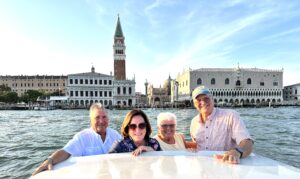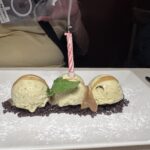Badajoz Monday August 26
Left Richmond for Philadelphia in the afternoon. Philadelphia, of course, was a madhouse. We had some time before our flight to Venice and, since we were flying business class, we could take advantage of Americans lounge. The one closest to our departure gate was under construction so we tried the next closest. The representative there was gating those wishing to enter and suggested we try one just 5 minutes away. It was way more than 5minutes away but we wandered there anyway. It was so crowded, there weren’t two seats together. Not a positive image for American!
Were traveling with John and Nelle Sieg.
We went to our departure gate, boarded, and settled in for our flight to Venice. The goal was to sleep since we arrived in Venice at 9:30 am on Tuesday and stay awake until 9 or 10 pm on Tuesday.
lumpishly Tuesday Arrival August 27
Bright and early Tuesday morning, we were met in Venice at the airport by our airport-to-hotel transfer. We drove a ways and then boarded a water taxi to make it to the Hotel Foscari Palace, our home until Saturday. We were early for check-in, so we dropped our bags and scoped out the area. There was lots of unique shopping nearby, and we wandered over to San Marco to figure out where we were to meet our guide Wednesday morning.
We lunched at a Japanese-fusion eatery, Zikiya, and continued our wandering. Dinner was at Al56zerooto, a ristorante pizzeria. On Tuesday, we covered about 4 ½ miles.
Wednesday August 28
We met our guide, Tullia, by the winged lion statue in the Piazza San Marco closest to the Grand Canal. Actually, there are two huge granite columns obtained from Constantinople standing side by side, one with San Teodoro, the patron saint of Venice before St. Mark’s relics were smuggled from Alexandria in the 9th century. This is a copy – the original is safely kept in the Palazzo Ducale. The other column is the base for a bronze of the Lion of St Mark. Venetians are superstitious: they will never walk between the two columns of San Marco and Teodoro.
Our first stop was the Basilica Di San Marco, which blends the architectural and decorative styles of east and west to create a Byzantine extravaganza embellished with golden mosaics, icons, and marble carvings. Built on a Greek cross plan and crowned with five huge domes, the basilica’s adornments consist of treasures from the Republic of Venice’s overseas empire.
Next, we visited the Palazzo Ducale or Doge’s Palace, a combination of Byzantine, Gothic, and Renaissance architecture. It was the official residence of the 120 doges who ruled Venice from 697 to 1797. The palace is embellished with painting and sculpture by Titian, Tintoretto, and Bellini and by architects Antonio Rizzo and Pietro Lombardo. The Sala Del Maggior Consiglio is one of the largest rooms in Europe and could seat up to 2000 council members.
We continued on upstairs in the secret corridors and chambers to learn about the fear that Palazza Ducale used to represent. We found the cell of Casanova from which the writer was able to escape, other prison cells, sites of torture, the bridge of Sighs, and the Doge’s armory. We also visited government offices and the court.
We left our guide and crossed the Ponte Della Paglia, built of Istrian stone with a pretty balustrade of columns and sculpted pine cones to Princesspessa for lunch.
Then off to the well in Campo San Toma to meet our guide for our food and wine tour in San Polo. Each campo or piazza has a well, but they are generally covered over. Water for Venetians now comes by aqueduct from the Dolomites and is quite good. First, we caught a traghetti, a gondola without adornment, just outside the hotel and crossed the canal for 2 euros per person cash to the oarsman. There are seven points between the train station and San Marco where they cross the Grand Canal. Many folks stand in these gondolas as they cross back and forth – but we decided to sit.
We visited authentic osterie in local neighborhoods of San Polo and Dorsoduro. We started our tour with Ludo just as the tourists begin to leave the city for the day. This is the time that Venetians head to cafes and bars to partake in their Apertivo ritual of pre-dinner drinks with light snacks. We sampled spritzes, were introduced to the Venetian favorite Select, as well as Aperol and Compari. Our guide told us that the Venetians of old drank spritzes since the water from the wells tasted horrible. We sampled delicacies at San Trovaso, Ristorante, osteria Alla Bijora, and osteria Pugni. Osteria Pugni is located at the foot of one of the Ponte del Pugni, or bridge of fists, with two pairs of footprints set in white stone at the top of the bridge. These mark the starting positions for fights between rival factions. These fights were.
so bloodthirsty that they were banned in the 1700’s. Tradition states that the reason gondoliers were red striped shirts versus blue striped shirts is tied to these fights.
We ended with dessert and a shot of house made gin before heading back to the Hotel Foscari Palace via the Ponte Accademia. We had learned that Venice is made up a series of little islands, each with its own campo, church and well. Every time you cross a bridge, you are setting foot on a different island.
Thursday August 29
Our guide, Silvia, came to our hotel to pick us up for our boat ride to Murano and Burano, two scenic islands in the Venetian lagoon. Murano is the most famous of the Venetian islands. It is a small archipelago of various islets connected by bridges and inhabited by about 4500 people. It has been the center of Venetian glassmaking since the 13th century when the local Venetian council decided that the furnaces used to make glass were causing too many fires in Venice’s wooden buildings and to protect the trade’s technological secrets – particularly those involved in making mirrors. The Venetians had created Cristallo – the clearest glass in the world. Some factories are now derelict, but the area still produces large quantities of glass.
We visited one of the only factories having demonstrations, since August is the month of vacations and closing down. Only one furnace was operational and we watched a master craftsman create a small glass horse and then make a vase. We visited the gallery showcasing the many pieces of glass art.
Afterwards, we boarded a boat and headed toward Burano via the island of Mazzorbo. On Mazzorbo, we walked through the gardens of a restaurant, including a vineyard of a golden grape, grown only here which produces less than 2000 half-liters of a golden white wine. It is bottled in a bottle produced in Murano and the label is hammered gold by a craftsman whose family have been goldsmiths for generations. Each half-liter bottle of wine carries a price tag of 200 euros!
We made our way to the back of the garden, filled with vegetables and fruit trees that support the restaurant. We had a great view of Torcello, which had a population of almost 20,000 but as Venice rose, it declined. It is now home of 11 people, but has 6 restaurants, and a Byzantine cathedral, the Basilica di Santa Maria dell’Assunta, which is the lagoon’s oldest building founded in 7th century but underwent restructuring in 11th century.
The Burano islet is connected via a pedestrian bridge from Mazzorbo. Burano is known for its bright, colorful houses along canal waterways and can be spotted from a distance by its tall, tilted tower of its church. The streets are lined with traditional lace/linen merchants and trattorias serving fresh fish. We had lunch here; I had a burrata and tomato salad! Houses here are not subject to the strict governing laws as they relate to color in Venice, so homeowners here choose vibrant, bright colors for their homes. A water taxi, piloted by Silvia’s husband picked us up and took us back to the Hotel Foscari Palace.
After a short break, we were back on the tourist trail with Silvia with a Cannaregio Aperitivo tour. We walked through the historic 16th century Jewish Ghetto. Caught sight of the Banco Rosso, Red Bank, one of the first banks – the reason when you overdraw your account, you’re in the red! Venice’s Jewish population was confined in an enclosed area here for more than 270 years until Napoleon annexed the Republic of Venice in 1797, ridding the area of its gates and allowing residents the freedom to live where they choose.
We made three stops at simple bars in this trendy and lively neighborhood. We stopped along the canal, ducked down alleys, to find spots for wine and traditional bites, cicchetti. It was a very warm evening and most folks enjoyed the outside spaces.
We were full and didn’t need dinner so we headed back to our hotel and stopped on the way for a Select Spritz. Our server was impressed that we wanted Select not Aperol, as that is what Venetians prefer.
Friday, August 30
 Today is Pat’s birthday, Happy birthday!
Today is Pat’s birthday, Happy birthday!
We made a reservation at VINI DA GIGIO based on a recommendation from one of our guides, Silvia. It was a great meal; we would recommend it to anyone who visits Venice.
Of course, Pat’s dessert of choice was pistachio gelato.
We have little scheduled today other than a sunset Grand Canal boat tour with Silvia. After breakfast, we took mandatory photos of the Rialto Bridge. The Rialto Bridge is the oldest of the four crossings over the Grand Canal. It’s in the middle of bustling activity on the water and each side of the canal. The bridge was completed in 1591 and was the only way to cross the Grand Canal on foot until 1854, when the Accademia Bridge was built. Venetians previously had to be ferried by gondolas.
We took the opportunity to visit the shops/stalls in this commercial hub of Venice and check out souvenirs. We stopped for lunch at one of the canal-side outdoor restaurants, with ceiling fans and misting units for comfort in the heat and to people-watch all the hustle and bustle. We headed back to the hotel to check out the roof top deck and to make some logical order out of our suitcases since we leave tomorrow for the Royal Clipper and our sailing adventure!




